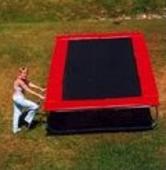Take the Trampoline Quiz based on your needs
The rate the springs slow you down and the part where the tenstion is the difference in the G force that it wil lcreate when it accelerates you back up. Some springs make the mat feel really responsive right when you land and other springs give their highest tension at the bottom of the bounce. Light weight people and kids will want to feel the G force not at the botttom at the point where the tapered springs ends give the G force (usually on longer springs is where this complaint comes from) but with shorter springs where you get to use the entire belly of the spring. A 90 pound kid will get totally different bounces with a 10 inch spring and a 7 inch spring. Most of the tension in springs usually comes at the end of the stretch where a pop instead of a push feel can be felt. At the lowest point of deceleration, it can push someone up or pop someone up. If the entire spring was engaged, the pop feel can be felt. But if the spring is too big for the mat and the weight of the person, all the person is going to feel is the push feel. This is one of the biggest reasons people return the other trampolines on my other site.
If someone is expecting a push and not a pop, then they will probably want to return it.
The amount of length the mat decelerates when someone lands determines the G force created. Some mats decelerate twice the distance as others and provide the same G force but spread out over more time. For example, a mat that decelerates only half way and gives the person 4 feet of acceleration into the air will have a totally different ballistic impact than the trampoline that decelerates double that and gives 4 feet of acceleration.
First, bungees give more bounce and higher tension springs allow for less bounce but way way way more G force per bounce than lower tension springs or bungees. There are companies that make lower tension springs that give a very softening bounce with lesser G force and those that have firmer springs but give too much G force which creates too much ballistic impact and it can hurt your knees and ankles.
If a mat decelerates more and the ballistic impact is nearly diminished, the momentum in the bounce will be kept and their will be many more free bounces but a mat that decelerates like this will require more energy to bounce. The mat and frame don't absorb the energy like it would if it decelerated half as much.
The trampolines that give a high bounce and absorb most of the ballistic impact at the lowest point of deceleration is weakened to the more feet traveled into the mat but the G force is also spread out and feels weakened. It is the same G force but just feels differently.
If doing stunts and acrobats, knowing where the most G force is created during the accelaration will usually cause someone to prefer one type over the other. Going quickly from being airborne to the bottom of the bounce needs a certain time to engage the muscles to do the next jump. If the deceleration is too slow or the mat sags or the springs are too long or the their are different tensions in the mat due to some springs with high tension and others gone bunk, it can make it harder to perform on the trampoline.
On my quiz, if there are any specific goals such as someone wants needs enough G force to do more flips or wants more bounces per minute with higher or lower G force but not to jump so high, let me know on my quiz. I believe I have enough experience dissecting these now that I can recommend the perfect spring and sizing setup and every other decision as long as I know what someone needs.
...because they all said they have the best quality and bounce
1-877-336-7890
Open from
8am till 10pm
Rectangle-Trampolines-Reviewed.com
1-877-336-7890
Open from
8am till 10pm




